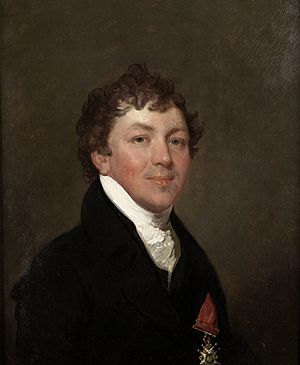Sir Henry Baker, 2nd Baronet facts for kids
Quick facts for kids
Sir Henry Loraine Baker
|
|
|---|---|
 |
|
| Born | 3 January 1787 Nancy, France |
| Died | 2 November 1859 (aged 72) |
| Allegiance | United Kingdom |
| Service/ |
Royal Navy |
| Years of service | 1797–1846 |
| Rank | Vice admiral |
| Commands held |
|
| Battles/wars | |
Sir Henry Loraine Baker (born January 3, 1787, died November 2, 1859) was an important officer in the British Royal Navy. He served in many big wars. These included the French Revolutionary Wars and Napoleonic Wars against France. He also fought in the War of 1812 against the United States. He became a Vice-Admiral and was known as the 2nd Baronet.
Contents
Henry Baker was born in Nancy, France. His father was Sir Robert Baker. His mother was Dinah Hayley. Her father, George Hayley, was a well-known politician in London.
Henry joined the Royal Navy in December 1797. He started as a volunteer on the ship Unite. He then served on the ship Cruizer. After that, he became a midshipman on Boadicea. He served in these ships in British waters until 1802.
Service in the West Indies
In July 1802, Henry joined Centaur. He helped capture Saint Lucia with Admiral Sir Samuel Hood. He then went to the West Indies again. He served on Theseus. Here, he took part in battles around Saint-Domingue.
Baker helped block Cape François. He also helped capture Fort Dauphin. During this battle, two forts and a French ship called La Sagesse were taken. He was also there when the French army surrendered.
Promotions and Battles
On July 16, 1804, Baker became an acting-lieutenant on the ship Surveillante. In March 1805, he moved to the ship Reynard. On March 20, Reynard destroyed a large French privateer ship. This was called General Ernouf. Because of this success, Baker's rank as lieutenant was made official.
In December 1805, he joined the Fortunée. From May 1806, he served as the first lieutenant on Mediator. He helped capture several privateer ships. He also took part in attacking a fort at Samaná in 1807. After this, he served on Veteran.
Walcheren Campaign and Anholt
Baker returned to Britain in late 1807. He served on Castor, then Eagle, and Leda. In August 1809, he commanded a gun-boat. He was praised for his role in bombing Vlissingen. This was during the Walcheren Campaign.
On August 15, 1810, he took command of a small ship called Anholt. He was second in command at the Battle of Anholt in March 1811. This battle was to defend Anholt island from a much larger Danish force. Baker's ship, Anholt, played a big part in defeating the enemy. He was promoted to commander on April 8, 1811.
War of 1812 and Later Career
On October 28, 1812, Baker was given command of the ship Conflict. On March 18, 1814, he commanded Fairy. Both ships were in North America. In August 1814, he took part in battles on the Potomac River. He helped capture Fort Washington. He also helped with the surrender of Alexandria. He was praised for his actions, especially for saving a ship called Devastation from the enemy.
After the surrender of Guadeloupe in August 1815, he was promoted again. He became a post-captain and received an award called Companion of the Bath.
On June 27, 1820, he married Louisa Ann Williams. They had two sons and five daughters. He became the second baronet after his father passed away in 1826.
On July 29, 1840, Baker became the flag captain on Howe. This was under Vice-Admiral Sir Henry Digby. In October 1841, he broke his leg and got other serious injuries. This happened while he was with the Lords of the Admiralty. He had to leave his command in December. On January 19, 1842, he received a pension. He was promoted to rear-admiral on November 6, 1850. He became a vice-admiral on July 9, 1857. Vice-Admiral Baker died on November 2, 1859.
See also
- Sherston-Baker baronets

